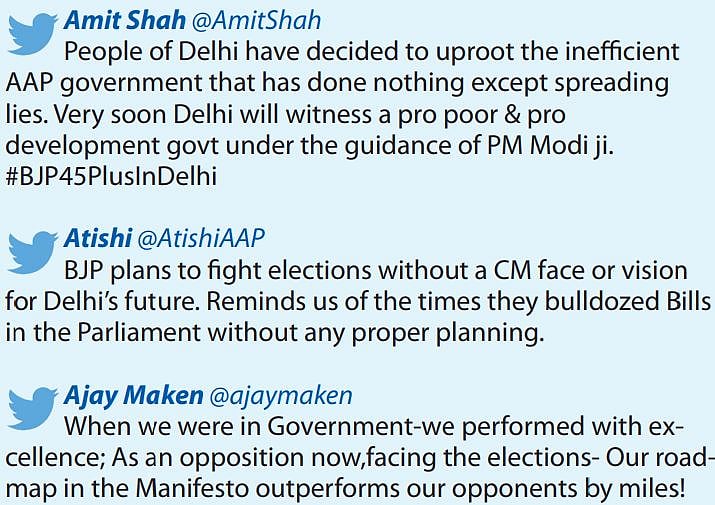An ugly battle for Delhi: BJP set to lose again
Although Modi, who addressed four poll rallies in 2015, appears marginally more subdued this time, the BJP has unleashed a bruising and communally charged campaign

Despite the Prime Minister, the Union Home Minister, several chief ministers of BJP-ruled states and central ministers campaigning for the BJP, three days before the polling, the party appeared set to lose the Delhi Assembly election once again.
It had secured three seats in 2015, down 29 from the 32 seats it had won in the election held barely some months ago. And five years later, an optimistic internal survey, leaked by the BJP, projected the BJP would win between 35-37 seats. It was telling because even this highly unlikely and ambitious number fell short of the majority mark.
A survey by Times Now, however, gave BJP 10-14 seats in the Assembly with a strength of 70. At the moment, therefore, the party appears poised to win between three and 14 seats, making a dent in the AAP tally of 67 but not enough to dislodge it from government.
AAP and the Congress on the other hand believe they are going to fare better. While AAP’s official stand is that it will make a clean sweep of all the 70 seats, Congress leaders believe the party is a dark horse and could well spring a surprise or two. The contest, they are hoping, will be a lot closer than what the media and poll pundits are predicting.
The Congress hopes to benefit from the BJP pushing national issues like CAA-NPR and NRIC to the centre. With BJP not keen to contest on local issues (although it controls the municipal corporations, the performance of the MCDs have been patchy at best) on which it believes AAP could have an edge, having created the perception at least of dramatically improving the conditions in government schools and introducing mohalla clinics and affordable medicare.
AAP is also banking upon the goodwill it generated by fulfilling its promise of lowering substantially the tariff for electricity and water. Therefore, while the AAP government may not have been as successful in dealing with air pollution, transport and parking bottlenecks, women’s safety, etc., it is perceived to have done enough to get a second term.
But with AAP and Chief Minister Arvind Kejriwal distancing themselves from ‘national issues’ and the Chief Minister declaring that had Delhi Police reported to the state government, he would have got Shaheen Bagh cleared in two hours—Congress would be hoping for some of the neutral or anti-BJP votes to switch to its side.
The Congress has two other aces up its sleeve. It appears to have consciously nominated a large number of candidates, who are far removed from the conventional mould of politicians. Young, educated and articulate, the new generation of candidates bring an air of freshness and if a section of the electorate, sandwiched between the high-octane and polarising campaigns of the BJP and AAP, put their trust in the young, the party might even improve upon its tally.
What’s more, the Congress manifesto appears to be better thought-out than its rivals’. Plenty of homework appears to have gone into the manifesto, as in the Lok Sabha manifesto last year, and the party seems to know how to implement the promises and from where to get the money.
For a relatively small state, Delhi, with a population of 1.9 crore packed in a much smaller area than, say Himachal Pradesh (one crore), Uttarakhand (70 lakhs) or Jharkhand (3.2 crore), has a substantial amount of money to spare.
While the annual expenditure budget of both Himachal Pradesh and Uttarakhand hover around ₹Rs 44,000 crore and that of mineral-rich Jharkhand around Rs 80,000 crore, Delhi last year proposed to spend Rs 60,000 crore. All the three other states have a much larger area to govern while Jharkhand has a larger population to address as well.
What is more, Delhi has the New Delhi Municipal Corporation (NDMC), DDA and several other bodies funded by the central government and also the Delhi Cantonment Board to take care of a large area. Delhi also benefits from a large floating population, migrants and because the adjoining states of Haryana, Punjab, Rajasthan and western Uttar Pradesh being relatively affluent.
While AAP continues to demand full statehood for Delhi, in the absence of full statehood, the Delhi Chief Minister has been compared to a glorified Mayor and the Delhi government perforce must deal with civic issues, improve the parks and playgrounds.
By distancing himself from national issues, Arvind Kejriwal, observers have said, has lowered his own political stature. He seems happy, they commented, to look after Delhi over which he doesn’t even have complete control and share power with the central government.
This has been an unusual move by the politically ambitious Chief Minister, who once took on the two national parties, the Congress and the BJP, and threatened to emerge as a national alternative.
While some degree of anti-incumbency is expected to affect AAP’s tally, a sharp drop in the number of seats will inevitably dent Kejriwal’s image. On the other hand, if AAP does manage a clean sweep, it will provide him with another opportunity to emerge as a challenger to Modi and Shah at the national level.
Now that it is clear that the BJP is losing Delhi, the puzzling question is why the Prime Minister and the Union Home Minister have staked so much on Delhi. True, the credit for any significant increase in BJP’s tally will go to them. But if the tally does not increase substantially, they run the risk of paying a political price.
After almost losing in Haryana, then losing power in Rajasthan, MP and Chhattisgarh before Maharashtra and Jharkhand, yet another defeat in Delhi will call into question the ability of the master strategist Amit Shah and his ‘masterstrokes’.

And although the Prime Minister, who had addressed four election rallies in Delhi in 2015, appears marginally more subdued this time, the BJP has unleashed a bruising and communally charged campaign against the Opposition.
The Election Commission, no longer surprisingly, has dealt with the ruling party with kid gloves. But the BJP’s campaign videos in Delhi brazenly seek votes against traitors, anti-nationals, urban naxals and such like. They demonise anti-CAA protestors and blatantly seek votes on an anti-Pakistan and nationalistic plank. So much so that Union Minister Prakash Javadekar publicly called Arvind Kejriwal a terrorist while another central minister, MOS Anurag Thakur, exhorted people attending an election rally to chant the cry, “Desh ke gaddaron ko goli maaro saalon ko”.
Even after the Election Commission took token action against Thakur and another BJP MP Pravesh Verma, who outrageously called the protestors at Shaheen Bagh as rapists and murderers, the party fielded them in Parliament, brazenly sending out the signal that it stood firmly with the duo. Of course, no central minister would have said or done what they did without the approval from the senior most leaders of the party.
But will it help the BJP win in Delhi? Even more importantly, will it help the BJP politically even after it loses the election?
Or, is the BJP going to spring a surprise, pull a Balakot out of its bag of tricks, and wrest power from AAP?
Follow us on: Facebook, Twitter, Google News, Instagram
Join our official telegram channel (@nationalherald) and stay updated with the latest headlines